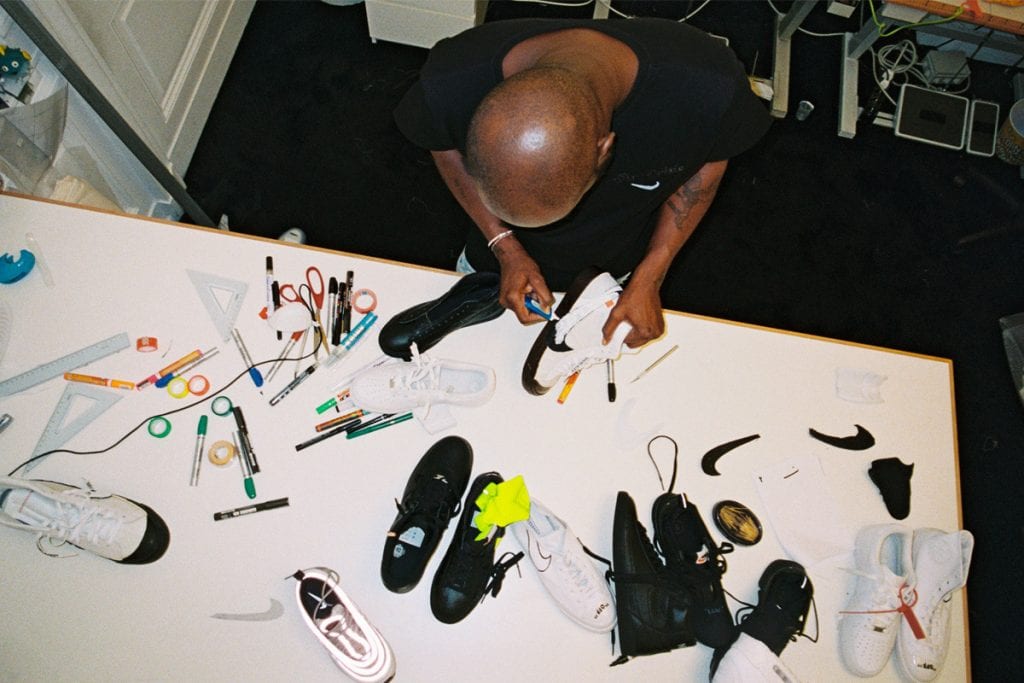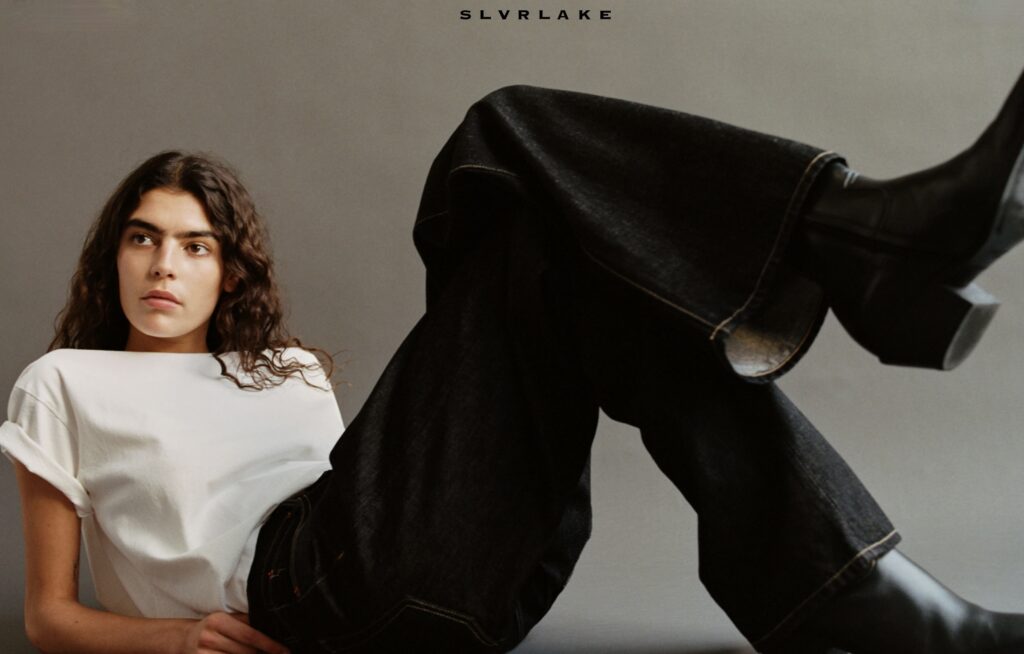Virgil Abloh attended Vogue’s inaugural Forces in Fashion event in New York with a bag from Louis Vuitton’s collection with artist Jeff Koons on his arm. The bag’s strap – which read “Louis Vuitton” c/o Virgil Abloh © 2017 – was eye-catching, as it seemed to indicate that Mr. Abloh, then 37, had been enlisted to roll-out a collaboration with the Paris-based design house in furtherance of his penchant for such pairings. It would be revealed thereafter that the bag was not, in fact, part of a looming collaboration, but instead, was a pre-cursor to Abloh’s tenure as menswear director for the Paris-based brand. At the time, however, the prospective of a collab was not outside of the realm of possibility given that Abloh is on something of a perennial collaboration spree.
Over the past few years, in particular, Virgil Abloh – and his brand Off-White – have been tied to a string of partnership projects, including but not limited to tie-ups with Nike, IKEA, Rimowa, Dr. Martens, Jimmy Choo, Warby Parker, and Champion, among others. One thing most of them have in common: regardless of whether the medium is a green grass-looking rug for Ikea that reads “KEEP OFF” or a Nike sneaker that is emblazoned with the word “AIR,” they make use of Abloh’s design signature, quotation marks. (Yes, the Chicago-born, world-based (he is never in the same place for longer than a few days thanks to these collaborative projects and an endless number of DJ gigs across the globe) designer has seemingly traded in his growingly distinctive diagonal lines logo – at least for now – for an abundance of quotation marks).
Exposure: A Balancing Act
Traditionally, brands have been cautioned when it comes to collaborations and their larger branding efforts, more generally, with the notion that too much exposure will lead to consumer fatigue, and a drop in sales (and prices). Louis Vuitton, for instance, learned a tough lesson after “going mainstream” so to speak, in the late-90’s and early-2000s, by upping the quantity of logo-covered goods that it was willing to manufacture and expanding its offerings in terms of price point to include more accessible, often logo-ed products.
The key takeaway from this exercise was relatively straightforward (in hindsight, at least): exposure is a double-edged sword. As Reuters noted years later, in November 2014, long after Louis Vuitton had begun to walk back on its market situation technique, this “volume-based strategy made shareholders [of the publicly-traded LVMH Moët Hennessy Louis Vuitton] rich, but it also diluted the [Louis Vuitton] brand.”
At the peak of what has since been labelled “logo fatigue,” discerning consumers closed their wallets to Louis Vuitton, demanding more discrete goods, and leading to several quarters of very slow growth for the Paris-based brand.
As such, the house did a 180-degree-turn in sales strategy and embarked upon a large-scale revamp of its product offerings. In an attempt to regain the favor of its deep-pocketed clientele, Louis Vuitton’s leather good division acted upon a vow that chairman Bernard Arnault’s made in a January 2009 earnings call: Louis Vuitton would be making changes. In addition to scaling back its real estate expansion plans, the brand would actively prune its portfolio of logo-emblazoned canvas bags, which were making up about two thirds of its business at the time and generating gross margins of 90 percent. Those offerings, including the ones put forth by then-creative director Marc Jacobs, who left the helm of Louis Vuitton in 2013 following the showing of his Spring/Summer 2014 collection, would be replaced, to an extent, by Nicolas Ghesquiere’s expensive leather and exotic-skinned bags with subtle – if any – exterior logos.
In re: Off-White
How does this relate to the multi-hyphenate industry figure that is Virgil Abloh and his buzzy Off-White brand? In theory, the takeaway demonstrated by the logo-infused saturation of the market by Louis Vuitton wares (and Gucci ones, too) and the subsequent need for a revamp in light of the resulting consumer distaste should apply here. And yet, it doesn’t seem to be a significant issue, at least not based on the continued efforts by Virgil Abloh and his brand. Quite frankly, despite Off-White’s potential over-extension of itself in terms of collabs, such stories of revenue-crippling dilution might not plague – or better yet, simply might not apply to – Abloh for more reason than one.
One of those reasons is the fact that to some extent, the notion of brand dilution might be outdated in an age of targeted marketing and user (i.e., algorithm)-dictated content. Unlike in the late 1990s, early 200s when Louis Vuitton and co. were preparing to be hit with a wave of fatigue, the apps we use learn , based on the accounts we follow and the posts we “like, what we are interested in, and then show us those things. In essence, consumers are – more than ever before – dictating the media (and the ads) they see, thereby, potentially removing the likelihood of broader dilution because we are only being shown, more or less, exactly what we are searching for and/or responding to.
Maekan co-founder Eugene Kan echoed this notion recently, saying, “The idea of dilution in fashion is an interesting thing these days. We live in an era of different channels and filter bubbles.” With that in mind, he says, “For however many collabs anybody may do, they are seen by: 1) the brand’s target demo, 2) rabid friends of the brand, and then … 3) general public.” And, as Kan aptly notes, “Big brand fans won’t care about dilution as much because well, they’re fans, right?”
What we do know is this: consumers consistently prove to be fickle, especially when they are spending large sums of money on products. While Abloh’s Nike sneakers and IKEA rugs might be affordable (especially for his younger fans), at least at the initial point of sale, the exposure of the Off-White brand name is being hoisted further into consumers’ psyches each time the brand puts its name on a new collab.
This is beneficial (to a point), as it stands to boost visibility for the cool-guy brand. However, at a certain point, will this prove dilutive of the Off-White brand and simply make it less desirable to those who are buying into the main collection and those opting for some of the more affordable collabs? Maybe. Maybe not. The thing is, though, even if dilution exists and does set in, Abloh may be uniquely positioned to fight off dilution to an extent, at least. Regardless of one’s feelings on his designs and his process, it is almost impossible to deny that he is groundbreaking and inventive when it comes to his brand and its branding. Such shifts in direction – from diagonal lines branding to the quotations when consumers began to slowly gravitate beyond the former, for instance – may be the key to longevity for Abloh’s brand.
If we have learned one thing from Abloh to date, it is to not underestimate him.











